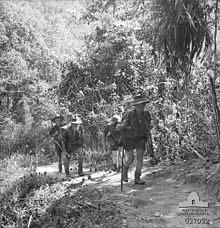2/1st Battalion (Australia)
| 2/1st Battalion | |
|---|---|
 Troops from the 2/1st at Wondecla, Queensland, April 1944 | |
| Active | October 1939 – December 1945 |
| Country | Australia |
| Branch | Australian Army |
| Type | Infantry |
| Size | ~800–900 personnel[1][2] |
| Part of | 16th Brigade, 6th Division |
| Colours | Black over green |
| Engagements | World War II
|
| Commanders | |
| Notable commanders | |
The 2/1st Battalion was an
History
Formation
Raised at
With an authorised strength of around 900 personnel,[2] like other Australian infantry battalions of the time, the battalion was formed around a nucleus of four rifle companies – designated 'A' through to 'D' – each consisting of three platoons.[6] After formation, a brief period of basic training was undertaken at Ingleburn, New South Wales, before the battalion embarked for overseas service on 10 January 1940,[3] aboard the SS Orford.[7]
Greece and the Middle East
After sailing via the Suez Canal, the 2/1st arrived in
The battalion arrived in Greece on 22 March and was quickly deployed to the north of the country to resist the anticipated German attack. The battalion took up positions at
The losses on Crete represented the vast majority of the battalion's personnel, but by June there were about 70 men from the 2/1st in Palestine, some of whom had managed to escape after the fall of Crete and some who had been brought back there after Greece, rather than landing on Crete. The decision was subsequently made to re-form the battalion, rather than disband it. This was done by transferring 200 experienced men from the 16th Brigade's other two battalions – the
New Guinea

After only a short period of respite, the 2/1st deployed to
After their return to Australia, a long period of reorganisation followed, during which the battalion was converted to the
The battalion was finally disbanded in December 1945.
Battle honours
The 2/1st received the following battle honours:[3]
- Bardia 1941; Capture of Tobruk; Mount Olympus; Brallos Pass; Retimo; Kokoda Trail; Eora Creek–Templeton's Crossing II; Oivi–Gorari; Buna–Gona; Sanananda Road; Nambut Ridge; But–Dagua; and Hawain River.
Commanding officers
The following officers commanded the 2/1st Battalion during the war:[3][18]
- Lieutenant Colonel Kenneth Eather (1939–41);
- Lieutenant Colonel Ian Ross Campbell (1941);
- Lieutenant Colonel Tom White (1942);
- Lieutenant Colonel Paul Cullen (1942–45).
References
Citations
- ^ Kuring 2004, p. 47.
- ^ a b c Palazzo 2004, p. 94.
- ^ a b c d e f g h i j k l "2/1st Battalion". Second World War, 1939–1945 units. Australian War Memorial. Archived from the original on 13 April 2014. Retrieved 13 April 2014.
- ^ Eather 2003, p. 11.
- ^ Long 1952, pp. 321–323.
- ^ Long 1952, p. 52.
- ^ Eather 2003, pp. 12–15.
- ^ Coulthard-Clark 1998, p. 176.
- ^ Coulthard-Clark 1998, p. 177.
- ^ Coulthard-Clark 1998, pp. 189–190.
- ^ Long 1953, p. 315.
- ^ Long 1953, pp. 336 & 419.
- ^ Keogh 1965, p. 233.
- ^ Cranston 1983, pp. 192–193.
- ^ Festberg 1972, p. 107.
- ^ Johnston 2008, pp. 195–205.
- ^ Johnston 2008, p. 242.
- ^ Johnston 2008, p. 5.
Bibliography
- Coulthard-Clark, Chris (1998). Where Australians Fought: The Encyclopaedia of Australia's Battles (1st ed.). St Leonards, New South Wales: Allen & Unwin. ISBN 1-86448-611-2.
- Cranston, Fred (1983). Always Faithful: A History of the 49th Infantry Battalion, 1916–1982. Brisbane, Queensland: Boolarong Publications. ISBN 978-0-908175-60-4.
- Eather, Steve (2003). Desert Sands, Jungle Lands: A Biography of Major General Ken Eather. ISBN 978-1-74114-182-5.
- Festberg, Alfred (1972). The Lineage of the Australian Army. Melbourne, Victoria: Allara Publishing. ISBN 978-0-85887-024-6.
- ISBN 978-0-521-51411-8.
- OCLC 7185705.
- Kuring, Ian (2004). Redcoats to Cams: A History of Australian Infantry 1788–2001. Loftus, New South Wales: Australian Military History Publications. ISBN 1-876439-99-8.
- OCLC 18400892.
- Long, Gavin (1953). Greece, Crete and Syria. OCLC 3134080.
- Palazzo, Albert (2004). "Organising for Jungle Warfare". In Dennis, Peter; Grey, Jeffrey (eds.). The Foundations of Victory: The Pacific War 1943–1944. Proceedings of the 2003 Chief of Army's Military History Conference. Canberra: Army History Unit. pp. 86–101. ISBN 978-0-646-43590-9. Archived from the originalon 9 March 2016.
Further reading
- Givney, E.C. (1987). The First at War: The Story of the 2/1st Australian Infantry Battalion, 1939–45, the City of Sydney Regiment. Earlwood, New South Wales: The Association of First Infantry Battalions. ISBN 9781862529656.

